 W
WThe Aldersbrook Estate is the name given to an Edwardian housing estate in Wanstead North-East London in the area of the same name. The estate is bounded by Aldersbrook Road to the south, Bush Wood to the west, Wanstead Park to the north, and the City of London Cemetery and Crematorium to the east. It is wholly in the London Borough of Redbridge, and borders Waltham Forest and Newham. One half of Aldersbrook is in the postcode district of E11, the other in E12. Some of the part in E12 was formerly part of Newham.
 W
WThe Barbican Estate is a residential complex of around 2,000 flats, maisonettes, and houses within the City of London in Central London, in an area once devastated by World War II bombings and densely populated by financial institutions. Originally built as rental housing for middle and upper-middle class professionals, it remains to this day an upmarket residential estate. It contains, or is adjacent to, the Barbican Arts Centre, the Museum of London, the Guildhall School of Music and Drama, the Barbican public library, the City of London School for Girls and a YMCA, forming the Barbican Complex.
 W
WBecontree or is an area approximately 4 square miles (10 km2) in the London borough of Barking and Dagenham. It is located 11 miles (17.7 km) east-northeast of Charing Cross and was constructed in the interwar period as the largest public housing estate in the world. The Housing Act 1919 permitted the London County Council to build housing outside the County of London and Becontree was constructed between 1921 and 1935 to cottage estate principles in the parishes of Barking, Dagenham and Ilford, then in Essex. The official completion of the estate was celebrated in 1935 with a population of around 100,000 people in 26,000 homes.
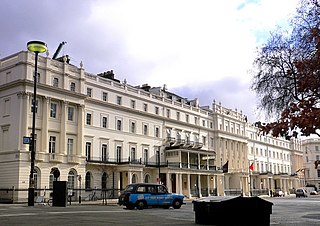 W
WGrosvenor Group Limited is an internationally diversified property group, which traces its origins to 1677 and has its headquarters in London, England. It has a global reach, now in 62 international cities, with offices in 14 of them, operated on behalf of its owners, the Duke of Westminster and his family. It has four regional development and investment businesses and a portfolio of indirect investments. Its sectors include residential, office, retail, industrial, and hotels.
 W
WBroadwater Farm, often referred to simply as "The Farm", is an area in Tottenham, North London, straddling the River Moselle. The eastern half of the area is dominated by the Broadwater Farm Estate ("BWFE"), a Corbusian experiment in high-density social housing, dominated by concrete towers connected by walkways, built in the late 1960s using cheap but fire-vulnerable pre-fabricated concrete panels. The western half of the area is taken up by Lordship Recreation Ground, one of north London's largest parks. Broadwater Farm in 2011 had a population of 4,844. The estate is owned by Haringey London Borough Council.
 W
WThe Carpenters Estate is located in Stratford, Newham, East London, adjacent to the Queen Elizabeth Olympic Park. The estate is formed of low rise social housing and three tower blocks. The estate has been continually earmarked for demolition and redevelopment.
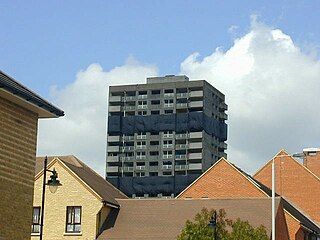 W
WCathall is a housing estate in the Cathall ward, Leytonstone, East London. It is currently managed by Community-based Housing Association.
 W
WCentral Hill is a social housing estate in the London Borough of Lambeth. It was designed by Rosemary Stjernstedt, Roger Westman and the Lambeth Council planning department during the directorship of Ted Hollamby. It comprises more than 450 homes built in 1966-74 near the site of the former Crystal Palace. Lambeth Council plans to demolish the estate so that it can build an extra 400 homes, many for private sale, so that it can finance the construction of new social housing.
 W
WChalkhill Estate is located in the Wembley Park area of North West London. It was originally one of three large council estates built in the London Borough of Brent by the early 1970s, along with Stonebridge and South Kilburn. The design was based on that of Park Hill in Sheffield. The high-rise estate was demolished by 2000 and gradually replaced by new low-rise builds.
 W
WChinbrook is an area of south east London, England, located 14 km (8.7 mi) southeast of Charing Cross in the London Borough of Lewisham. Chinbrook lies between Grove Park and Mottingham, approximately half a mile east of Grove Park centre and is generally considered part of Grove Park.
 W
WA council house is a form of British public housing built by local authorities. A council estate is a building complex containing a number of council houses and other amenities like schools and shops. Construction took place mainly from 1919 after the Housing Act 1919 to the 1980s, with much less council housing built since then. There were local design variations, but they all adhered to local authority building standards.
 W
WCressingham Gardens is a council garden estate in Lambeth. It is located on the southern edge of Brockwell Park. It comprises 306 dwellings, a mixture of four, three and two-bedroom houses, and one-bedroom apartments. It was designed at the end of the 1960s by the Lambeth Borough Council Architect Edward Hollamby and second architect Roger Westman, and built at the start of the 1970s. In 2012 Lambeth Council proposed demolishing the estate, to replace the terraced houses by apartment blocks. Most of the apartments would then be for sale to the private sector. The residents, those in Lambeth who wish to prevent the gentrification of the borough, and those who want to conserve what they believe to be important architectural heritage, are campaigning to prevent its demolition.
 W
WThe Downham Estate is a London County Council cottage estate in Downham, south east London. It is mainly in the London Borough of Lewisham and partly in the London Borough of Bromley.
 W
WEast Village is a housing development in Stratford, East London that was designed and constructed as the Olympic Village of the 2012 Summer Olympics and has been converted for use as a new residential district, complete with independent shops, bars and restaurants. The area was formerly contaminated waste land and industrial buildings to the north of Stratford town centre.
 W
WEnfield Island Village is a modern housing estate in Enfield Lock, in the London Borough of Enfield, north London. Before April 1994, Enfield Island Village formed part of the Epping Forest district of Essex, but it was transferred to the borough of Enfield in Greater London when the housing development was created.
 W
WThe Excalibur Estate is a post-war 1940s housing estate of 189 prefabricated houses in Catford, South London. The estate contains the last sizeable collection of post-war prefabricated houses in the United Kingdom. In 2011, Lewisham Council approved a plan to replace the prefabs with 371 houses, and demolition was scheduled to begin in 2013. English Heritage has granted listed building status to six of the "prefab" houses. The proposed demolition has led to campaigns from residents, English Heritage and the Twentieth Century Society to save the properties, and a legal challenge to prevent redevelopment if they are demolished and return it to parkland.
 W
WThe Golden Lane Estate is a notable 1950s council housing complex in the City of London. It was built on the northern edge of the City, on a site devastated by bombing during the Second World War.
 W
WHainault is a large suburban housing estate in northeast London in the London Borough of Redbridge. It is located 12.5 miles (20.1 km) northeast of Charing Cross. Most of the housing in Hainault was built by the London County Council between 1947 and 1953. Originally spanning the parishes of Chigwell, Dagenham and Ilford, in 1965 the area was combined in a single London borough and became part of Greater London. It is adjacent to the Metropolitan Green Belt, bordered on the east by Hainault Forest Country Park and to the north by open land and the boundary with the Epping Forest District of Essex. For postal addresses, it is split between the Chigwell and Ilford post towns and it is within the London 020 telephone area code. The area is served by London Underground's Central Line.
 W
WHanger Hill is a local area and ward of the London Borough of Ealing around Hanger Lane, most often considered a part of Ealing proper.
 W
WThe Hyde Park Estate is a residential district in the Paddington area of London. It is an affluent area, characterised by a layout of squares and crescents, and is home to several embassies, prestigious businesses and celebrities.
 W
WThe Ladbroke Estate was a substantial estate of land owned by the Ladbroke family in Notting Hill, London, England, in the early 19th century that was gradually developed and turned into housing during the middle years of the century, as London expanded. Characterized by terraces of stuccoed brick houses backing onto large private garden squares, much of the original building remains intact today, and now forms the heart of one of London's most expensive and fashionable neighbourhoods.
 W
WLancaster Road (West) Estate is a housing estate in North Kensington, west London.
 W
WThe Larner Road Estate was a housing estate located in Erith, Bexley, south east London. Demolition of the estate began in 2013, as preparation for a new development known as Erith Park.
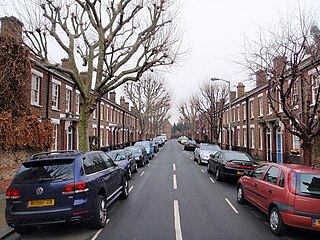 W
WLatchmere Estate is a housing estate in Battersea, Greater London, which was constructed in 1903. It is the first example of a housing estate built with labour directly employed by a local council authority.
 W
WThe Middlesex Street Estate is a housing estate in the Portsoken ward on the east edge of the City of London. It was connected to other local building by an elevated walkway system called the City of London Pedway Scheme.
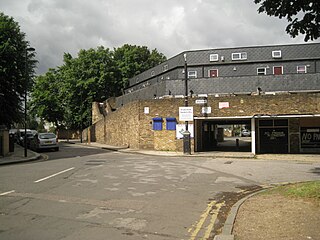 W
WMyatt's Fields South is a social housing estate located between Brixton Road and Camberwell New Road in South London. It is on land that once formed part of the Lambeth Wick estate.
 W
WNoel Park in north London is a planned community built in the late 19th and early 20th centuries consisting of 2,200 model dwellings, designed by Rowland Plumbe. It was developed as the Noel Park Estate on a tract of land on the edge of north of London as part of the fast growing development of Wood Green. It is one of four developments on the outskirts of London built by the Artizans, Labourers & General Dwellings Company. From 2003 to sometime in 2009, the name was also given to a small park near the southern edge of Noel Park, formerly known – and now known again – as Russell Park.
 W
WNorthumberland Park is a ward in the Tottenham area of London Borough of Haringey, in Greater London, England. It is largely residential, consisting of houses and flats. It is the location of Tottenham Hotspur Stadium, the home ground of Tottenham Hotspur F.C.. The ward is represented by three Labour councillors.
 W
WThe Old Oak and Wormholt estates are London County Council cottage estates constructed between 1912 and 1928. They were declared a conservation area in May 1980. The two estates were influenced by Ebenezer Howard's Garden city movement and the Arts and Crafts movement, which high quality external detailing and an open setting with privet hedges, front gardens and wide grass verges.
 W
WPhipps Bridge is a housing estate in Mitcham in the London Borough of Merton. It was built following a need created by the end of the Second World War on the site of old slums, and is named after a nearby bridge. Although it opened in the 1960s as a show-piece estate it took less than ten years for it to become a slum again, and the council continued to redevelop it into the 1990s.
 W
WRamsden is an area in south-east London, generally considered a suburb of Orpington, located in the London Borough of Bromley and the historic county of Kent. It is situated south of Derry Downs and St Mary Cray, east of Orpington town centre and north of Goddington. It was built as a council estate in the 1950-60s and is directly adjacent to the London Green Belt.
 W
WSouth Kilburn is a large housing estate in Kilburn, in the London Borough of Brent. Typical of brutalist 60's designs of public housing in the United Kingdom it is characterised by high-density housing in low-rise flats and 11 concrete tower blocks. It was approved in 1959 and extended in 1963. This scheme was further developed in the late 1960s and early 1970s. The population is predominantly Afro-Caribbean.
 W
WThames View Estate is a large housing estate in East London, England near Barking.
 W
WThe Warner Estate is an area of housing in Waltham Forest in East London. The area was developed by Thomas Courtenay Warner and the Warner Company.
 W
WWinstanley Estate and York Road Estate are large estates of predominantly public housing apartments in Battersea, London, adjacent to Clapham Junction railway station, although some have since passed into private ownership.
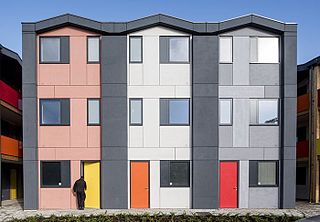 W
WY:Cube is a three-storey block of 36 one-bedroom affordable housing flats, owned by YMCA St Paul’s Group. They include George William Court, 148 Clay Avenue and flats 36A-E Woodstock Way in Mitcham in London, England. George William Court was named after the founder of YMCA, George Williams.